CD – 10 tracks – 65 minutes
Artwork: Jon Wozencroft
Mastered by Denis Blackham
Track listing:
01: La Anunciante
02: Los Mochis
03: Sierra Tarahumara
04: El Divisadero
05: Crucero La Joya
06: Chihuahua
07: Aguascalientes
08: Mexico D.F.
09: El Tajin; El dia y La noche
10: Veracruz
“Take the ghost train from Los Mochis to Veracruz and travel cross country, coast to coast, Pacific to Atlantic. Ride the rhythm of the rails on board the Ferrocarriles Nacionales de México (FNM) and the music of a journey that has now passed into history.”
El Tren Fantasma, (The Ghost Train), is Chris Watson’s 4th solo album for Touch, and his first since Weather Report in 2003, which was named as one of the albums you should hear before you die in The Guardian. A Radio programme was broadcast on BBC Radio 4 on Saturday 30 Oct, 2010, produced by Sarah Blunt, and described as “a thrilling acoustic journey across the heart of Mexico from Pacific to Atlantic coast using archive recordings to recreate a rail passenger service which no longer exists. It’s now more than a decade since FNM operated its last continuous passenger service across country. Chris Watson spent a month on board the train with some of the last passengers to travel this route. As sound recordist he was part of the film crew working on a programme in the BBC TV series Great Railways Journeys. Now, in this album, the journey of the ‘ghost train’ is recreated, evoking memories of a recent past, capturing the atmosphere, rhythms and sounds of human life, wildlife and the journey itself along the tracks of one of Mexico’s greatest engineering projects.
The radio broadcast received national press coverage in the UK:
The Observer:
It is over a decade since FNM operated its last continuous passenger service across the country but here sound recordist Chris Watson recreates its atmospheric journey with the help of the train recordings he made while working on the BBC television series Great Railway Journeys… through desert and city, but it is the rocking rhythms of the train itself that prove most memorable. [Stephanie Billen]
The Financial Times:
El Tren Fantasma (8pm) is Archive on 4’s recollection of a trans-Mexico rail journey by sound recordist Chris Watson. From desert to rainforest, hummingbirds’ wings to the boom of heat rising from the Copper Canyon, it recalls a beloved passenger train system abandoned by privatisation. **** [Martin Hoyle]
The Daily Telegraph:
Sometimes, radio can awaken the mind and sharpen the senses like no other medium. This “sound portrait” of a now-abandoned railway line that used to run between the Pacific and Atlantic coasts of Mexico is a good case in point. Captured by sound recordist Chris Watson more than a decade ago, it jostles with human, animal and mechanical life, filling the room with an atmosphere that is more richly evocative of Central America than any TV travel show I’ve seen. Diesel engines thrum, cicadas chirrup and passengers chatter, sing and argue. [Pete Naughton]
About the author…
Chris Watson is one of the world’s leading recorders of wildlife and natural phenomena, and for Touch he edits his field recordings into a filmic narrative. For example. the unearthly groaning of ice in an Icelandic glacier is a classic example of, in Watson’s words, putting a microphone where you can’t put your ears. He was born in Sheffield where he attended Rowlinson School and Stannington College (now part of Sheffield College). In 1971 he was a founding member of the influential Sheffield-based experimental music group Cabaret Voltaire. His sound recording career began in 1981 when he joined Tyne Tees Television. Since then he has developed a particular and passionate interest in recording the wildlife sounds of animals, habitats and atmospheres from around the world. As a freelance recordist for film, tv & radio, Chris Watson specialises in natural history and documentary location sound together with track assembly and sound design in post production.
Reviews:
Aquarius Records (USA):
This awesome Watson disc, now repressed and back in stock!
Preeminent field recordist Chris Watson returns with a bit of a twist on El Tren Fantasma. Pretty much all of his work up to this point (outside of his contributions to Cabaret Voltaire and The Hafler Trio way back when) has been audio verite. Even such albums as Weather Report, which edit field recordings from the African savanna (for example) into a condensed journey, are pristine, realist documents codified through the exquisite, lush details in Watson’s environmental sounds such as that of a lion panting after a successful hunt. El Tren Fantasma is much more engineered, imagined, and processed than anything else in his solo career; and this fictionalized Watson is no less compelling, no less dramatic, and no less awesome.
El Tren Fantasma – The Ghost Train – traces a now-defunct passanger rail line which ran from the Pacific Coast of Mexico to Veracruz on the Atlantic Coast. Watson had the opportunity to make this journey while working as a sound recordist for the BBC for their Great Railway Journeys. His compositions work with extracts from that excursion travelling across Mexico along with archival recordings whose origins are not specified. As he’s stopping throughout the Chihuahuan Desert, Watson does capture the stunning chorales of chirping frogs, buzzing insects, and the blaring call of a California Quail (whose syllabic chortle is often mnemonically transcribed as “chi-CA-go” as if it were seeking a more temperate climate); but it the train’s power and mass that provides so much of the impact for Watson’s album. By the fourth track “El Divisidaro,” Watson captures a series of loops of the train – with the bellowing horn pitched back and forth into a sustained symphonic tone and the clatter of the train’s engine becoming an ersatz rhythm track, which in turn gets tricked out with some Martin Hannett styled, phasing delay work. It’s easy to get lost in the majesty of this track, much like the expressive electronica that Wolfgang Voigt produced on Konigsforst as Gas. What a brilliantly simple transformation executed to perfection! “Mexico D.F.” reprises this strategy with rhythmic churns building out of the grinding brakes and the roiling tumult of steam blasting through the train’s pipes, becoming an almost militant thump on a lone drum. The train’s horn drifts suitably in a cloud of reverberation at the end of the album, dissolving into the ghostlike apparition Watson intended it to be. As brillliant as this work is, we should also point out that Watson is not alone in composing such fictionalized scores purely through environmental sound. We would be remiss if we failed to point out the work of Australian composer Tarab, whose deft psychogeographical albums share the scope and execution with Watson’s El Tren Fantasma. So great!
Andrew Weatherall writes for Caught by the River (UK):
If your fifty things to do before you die list includes, ‘Take the Ghost Train from Los Mochis to Veracruz across country, coast to coast, Pacific to Atlantic,’ you can forget it. El Fantasma is no more. However, thanks to Chris Watson’s months spent on board travelling with some of the last passengers to ride the route and his subsequent recordings you can tick it off as ‘achieved’ and turn your attention to ‘driving Route 66′ or ‘Pamplona bull run’. That’s how evocative this piece of work is.
I’ve taken the trip, courtesy of Mr Watson, on a number of occasions but like any rail journey one undertakes regularly, although physically and geographically the same, in terms of evocation, memory and feeling they differ greatly each time. The aural equivalents of Marcel’s biscuit dunking moment change, morph and crystallize into a million thoughts and memories every time you leave the station. That’s how evocative this piece of work is.
Trying to describe Watson’s work would be like sharing last night’s dreams and you don’t want to hear about my suppressed feelings of wistful romantic regret, fear of ageing [that’s the teeth falling out one],fear of the future or be taken on my erotic flights of fancy. I’ll stick to a sonic description and let you dream your own dreams.
As a thundering locomotive is given life by delicate micro-engineered machine parts El Tran Fantasma is given life by delicate micro-engineered machine manipulation. A train’s warning klaxon is, for a split second, shaped into the dieing moment of a symphony’s last chord which in turn becomes a drone underpinned rhythmically by the rattle of rails. Sub-bass looms out of shunting yards and ether. Flies hovering over carrion sprout metallic wings until disturbed by clanging bells. Violent jolts as you enter tunnels and the air sucked out on exit shapes itself into distant church choirs. Jet-streams form delicate chords and harmonies.
At the same time none of this manipulation is heavy-handed or gimmicky and never detracts from the quality of the actual field recordings themselves. Frequencies are gently teased to provide triggers one would otherwise get visually from the actual journey. They talk of hazey daytime heat and damp nighttime cold. Of shimmering plains and lost histories. And that’s just the first stop.
“I’m giving you the complete works of Shakespeare and the Bible, your luxury is a never ending supply of Hine cognac; what’s the one record you would take with you if push came to shove?”
“That’s a tricky one Kirsty, but I guess it would have to be Chris Watson’s El Tran Fantasma. A benchmark in field recording not to mention a map of the soul, an insight into the human condition and a key to dreams.
The Milk Factory (UK):
Railways have often provided electronic-based musicians with a wealth of rhythmic and mechanical sounds, from Pierre Schaeffer’s early tape experiments to Krafwerk’s hypnotic journeys across Europe. A former member of Cabaret Voltaire and The Hafler Trio, Chris Watson may have at one time been keen to explore similar concepts, but his work as a sound recordist in the last thirty years has taken him on a very different path. Watson works primarily with wildlife, and his work has been featured on many natural history programmes for the BBC, most notably David Attenborough’s series, from The Life Of Birds to Life In Cold Blood, and Bill Oddie’s Springwatch and Autumnwatch series. Beside these, Watson has released three albums of field recordings on Touch and has collaborated with a number of experimental musicians on further recordings and installations. This album is his fourth solo record for Touch.
El Tren Fantasma is a slightly different project, as it documents a cross country train journey on board the Ferrocarriles Nacionales de México (FNM), from Los Mochis on the Pacific coast to the west to Veracruz on the Gulf of Mexico to the east. The service ceased to operate over ten years ago, but Watson, who was then part of a crew filming a documentary for the BBC, Great Railway Journeys, spent a month on the service shortly before it was withdrawn, recording everything from the lulling clunk of the wheels on the tracks and wildlife sounds collected en route to some of the last passengers traveling on the service and station or on board announcements. These recordings were used again recently as part of a BBC Radio 4 programme, and they are given a further lease of life with this document of a time now gone.
This journey on what Watson suitably calls El Tren Fantasma (The Ghost Train) is extremely hypnotic and evocative. The album opens as trains slow down and come to a stop or painfully pull out, ready for the journey ahead, while announcements, partially buried in noise, can be overheard. This is the beginning of the journey, and one cannot help but feel a tremor of excitement as the sound of a diesel engine temporarily swallows the clunking noise of metal on metal and the strident hisses as wheels grind again rails and breaks against wheels.
Watson doesn’t aim to recreate the journey in any consistent chronology. Instead, he gives a taste of what this journey actually was by using nature and wildlife sounds to hint at the landscapes passed on the way. Equally, the slight changes in tone or rhythm of the train noises also provide elements on the route. This is amplified quite drastically on El Divisadero as the steady rhythm created as the wheels go over the joints resonates and bounces as if it came from the bottom of a narrow valley.
There is very little of the passengers themselves here, which is most probably explained by the fact that Watson concentrated on recording the train sounds and noises as support to the documentary, whilst passengers would have no doubt been interviewed or recorded by a different team. This somehow leaves a noticeable gap throughout, but Watson compensate this by offering a wider and more complete impression of the journey by stepping out and documenting trains on the move from the side of the railway track.
Inspired by Pierre Schaeffer, Chris Watson’s El Tren Fantasma is in essence different to the French composer’s 1948 Etude Aux Chemin De Fer in that the sounds are used to document a particular event whilst Schaeffer worked with his sound sources to create a stand-alone sonic realm, yet it captures similar sounds and textures, and occasionally end up hinting at more than a simple archival process. With this record though, Watson not only brings the journeys he recorded back to life but creates an extremely vivid soundtrack. 4.4/5
The Sound Projector (UK):
Chris Watson‘s El Tren Fantasma (TOUCH TO:42) is a new work where he’s using his field recording and editing skills to create an elaborate electro-acoustic collage, a suite of ten pieces which almost tells a story. It has something to do the with Ferrocarriles Nacionales of Mexico (whose logo even appears on the disk artwork) and “the music of a journey that has now passed into history”. When he began releasing his intense field recordings as music CDs to be listened to, Watson pretty much served up pieces of nature in the raw, including animal roars and bird song from some far-out exotic locations, and did not really attempt to tell stories very much; instead the trademark of his exacting liner notes was to detail the recording equipment used, give very precise map locations, and the precise time and date. He was the sonic scientist logging his experiments, in case anyone wanted to repeat them. Later, with the African suite on 2003′s Weather Report, he started to meld, merge and elide several recordings together, creating a much more narrative-like epic sweep across time and space, and also building a very exotic and “impossible” vision of reality. I would situate this “Ghost Train” record in this latter vein.
With the splendid old photographs and map drawing that adorns the cover, this composition is a piece of sonic “magical realism”, Gabriel García Márquez as a series of vivid sound portraits. There are recordings of engines chugging along, on some quite antiquated machinery by the sound of things, and several stopping points in the journey where the listener is immersed in bird song, insects buzzing, and all the things that make the environment so vital and alive to Watson’s sensitive mics. The journey is framed, like a poem that uses ring-composition, with a railway announcer’s voice speaking in Spanish and English; while we’re exhorted to board the ghost train at the start of the piece, the final track sadly announces that the service is now closing down. It’s my guess that both of these clips must have been contrived in some way (they don’t feel like authentic documentary captures), but either way they are pure poetry. In the second one, this anonymous woman has so much finality in her tone she sounds like the voice of God, closing down the world.
Another way in which Watson’s technique has evolved is the fact he now allows post- production treatments; the most noticeable is that the sound of the engine machinery has been heavily processed so that, for a good deal of the record, it doesn’t really resemble a train at all, but has been filtered down into a series of digitally-smooth clunks, thumps and clanks. To put it another way, we’re hearing digital music that is fashioned using the rhythm of the train as a trigger device, like a studio drum programmer with his “gated drums”. In like manner, train whistle recordings are heavily echoed and stretched until they turn into ambient drone music. At first, this seemed to me to run counter to Watson’s original ethos of authenticity and truth in documentary recordings. But then it’s clear that El Tren Fantasma is not a documentary at all, but a valedictory paean for a vanished age of locomotion (something which is even more under threat with the menace of high-speed trains this century). As such, these treatments succeed in rendering the train into a true ghost, an echo of its former self, and its phantom runnings through tunnels and over dusty tracks become that much more poignant thereby.
It remains to mention two related precedents for this release. The first is Runaway Train (ASH 1.9), a 1994 release on Touch’s sister label Ash International. This is a “found” tape rather than a composition, but it has a life-or-death subtext which is not too far removed from El Tren Fantasma. The driver of Runaway Train may be about to end up as a ghost himself. There’s also something indefinably compelling about the distortion of the voices on both records; unexpected messages from the past. The second precedent is Pierre Schaeffer’s famous Étude aux chemins de fer from 1948, and Watson himself explicitly tells us El Tren Fantasma is “Inspired by Pierre Schaeffer’. Yes, both composers used the same source material and made music from the sounds of trains, but I think what’s also important is that Schaeffer’s early piece of tape collage is widely regarded as the first published statement of musique concrète, and is often used as a touchstone by others (Lionel Marchetti is one I can think of who has quoted it in his own work). Étude aux chemins de fer is as historically important as one of the earliest pieces of cinema – L’Arrivée d’un train en gare de La Ciotat by the Lumière Brothers (1895) which, very coincidentally, shows a train arriving at a station.
Quietus (USA):
The fourth episode of the fourth series of the BBC’s Great Railway Journeys was broadcast on the January 26th 1999. Presented by chef Rick Stein, it featured The Ghost Train, the now-defunct railway which travelled across Mexico from Los Mochis on the Pacific Coast and over the country’s spine to Veracruz in the east. This continent-crossing railway, part of the Ferrocarriles Nacionales de México (FNM), had to climb 8,000 feet, travel alongside canyons, through ranch country and pine forests, and skirt shanty towns. Chris Watson, sound artist and founder member of Cabaret Voltaire, was working as audio recorder for the BBC on the programme. He spend a month travelling up and down on the Ghost Train, recording the sound of the railway, the people who rode on it, and the landscape through which it travelled.
Yet El Tren Fantasma is so much more than a field recording of that trip. On that simple level, Watson’s technical brilliance is in creating depth and space in sound. You actually feel the train coming towards you in ‘Los Mochis’, while listening to the ambient, relaxed moments – conversation, birds tweeting – the complex, three dimensional sound places you in a ghostly, auditory diorama.
There’s the great myth that nature is silent. Throughout, we hear the sound of wind in trees and grass, birds calls, weather. The Ghost Train is an interloper, human but unnatural, a giant metallic other clanking through the landscape. In fact, nature often sounds just as (if not more) menacing than the machinery and ephemera of the railway. ‘Crucero La Joya’ is a case in point, flies buzz, a rattle comes and goes. The affect is startling, even sci-fi apocalyptic. Penultimate track ‘El Tajin’ begins with a cacophony of animal and insect sounds, oppressive and seemingly recorded at night. Without the certainty of the train, all this undefinable noise leads our minds into fear of the unknown. Watson is recording the landscape before it was tamed by the demystifying, ‘civilising’ influence of our technology.
Is this music? Musique concrète and industrial opened the debate over whether mechanical, unmelodic sound could be appreciated and enjoyed by a listener as musical form. It’s a debate that will no doubt continue, tediously, until long after the apocalypse humanity is divided between those who found acoustic guitars amidst the ruins of our cities, and the rest of us who will enjoy the clatter of rocks on metal detritus.
Melody, structure, rhythm and atmosphere emerge and sink into the field recordings. Indeed, a strange result of repeated listens is that the musical elements that seem to come to the fore. Some of ‘Los Mochis’ electronic pulse is reminiscent of Throbbing Gristle’s Second Annual Report, the trebly crescendos in Los Mochis suggest Stephen O’Malley and Peter Rehberg’s KTL. The train’s horn on ‘El Divisadero’ blares past before disappearing into a deep, bass thrum, making a tunnel of your inner ear. When it emerges, the wheels on rail joints become a one-two beat, a warm enveloping hum descends. It wouldn’t sound out of place delivered by, say, The Haxan Cloak or Brian Eno.
In El Tren Fantasma Chris Watson creates an evocative sonic portrait that juxtaposes the human-made sounds of the railway and the surrounding landscape. Now, Google searches for Los Mochis to Veracruz will tell you nothing about a railway, but simply turn up details of cheap air fares. Aircraft noise (that bugbear of the field recorder) 30,000 feet above the sounds of the Mexican terra firma would hardly have the same resonance as this. As the wild interior of Mexico now reclaims much of the railway’s trackbed, Chris Watson’s record is haunting, powerful tribute and memorial to a marvel of engineering and the people who built, worked and travelled upon it. [Luke Turner]
Record Collector (UK):

BBCi (UK):
In his book Civilizations, historian Felipe Fernández-Armesto focuses on man’s overriding impulse to impose its will on the world, “a relationship to the natural environment, recrafted, by the civilising impulse, to meet human demands”. This process lies at the very heart of El Tren Fantasma, a composite document of a train ride across Mexico, describing a passage “from Los Mochis to Veracruz, [from] coast to coast, Pacific to Atlantic”.
While Chris Watson’s previous sets – such as 2003’s critically acclaimed Weather Report – have generally concerned themselves with this planet’s myriad beasts and habitats, this narrative inevitably bears an anthropological mark. Indeed, the first voice we hear doesn’t belong to a cuckoo or coyote, but station announcer Ana Gonzalez Bello putting out one “last call for the ghost train”. It’s an unusually contrived opening gambit, from which point the listener is jettisoned into a collision of screeching breaks, rolling stock rattle and hot hydraulic huff. Over half of El Tren Fantasma’s tracks (pun definitely intended) are given over to locomotive sound – gears shifting, hoots, bells and whistles – climaxing with El Divisadero, where Watson manipulates the monolithic machinations into a surging, phantasmal bellow, like a choir of angels struggling to be heard over the rumbling thrum of running gear. Imagine if Phill Niblock had scored Different Trains instead of Steve Reich and you’d be somewhere close.
But it’s during the points of human absence that El Tren Fantasma works best. Here Watson’s ability to create whole worlds, entire lifetimes in the listener’s imagination, beyond the moment of recording, comes to the fore. Brushwood and tall grass sway beneath the breeze crossing canyon slopes, while constant cicada chatter is punctuated by the distinctive calls of woodpecker and crow. Pieces such as Sierra Tarahumara and Crucero La Joya exhibit an uneasy, natural repose; pregnant with calm, yet forever teetering on the brink of an automated avalanche. Indeed, it might be with heavy heart that you hear the train’s clanging signal bell presaging its oncoming passage. In this particular man versus nature fight for survival, it’s the latter that wins by a knockout. [Spencer Grady]
The Liminal (UK):
The title of the sound recordist Chris Watson’s new CD, borrowed from a Mexican film from the 1920s, translates as “The Ghost Train”. The name makes reference to the fact that the recordings were made while he was working on the BBC show Great Railway Journeys, where he took a ride on one of the very last passenger trains which ran from Mexico’s Pacific coast to the Gulf on the other side, a journey that since 1999 can no longer be made. However, as you listen to it while studying a map of the route, from Los Mochis in the west, through Chihuahua and Mexico City to Veracruz on the east, you begin to trace a number of branch lines which lead off from the main line. You find yourself making connections, hitching your wagon to a number of different trains, in order to chase down some fascinating – and very resonant – ghosts from Mexico’s history.
The record starts with the gathering roar of a train, approaching at speed from distance. In this instant, Watson has captured the excitement of the early days of steam trains, and I already find myself listening with an almost child-like glee. Construction of Mexico’s train network begin fitfully in the 1830s, but gathered pace in the 1870s as the result of foreign speculation – English, French, Belgian companies all seeking to profit from Mexico’s expansion. Its last great act of construction was the spectacular feat of engineering which is the train line through the country’s Copper Canyon: 390 miles long, with 39 bridges and 86 tunnels, allowing the train to climb from sea level to around 2,500 metres. Watson captures the speedy procession across the plateau in a most musical way, the whine of the train swelling almost orchestrally over its metallic percussion. He then lingers awhile in the canyon’s Sierra Tarahumara to record the sound of heat rising from its floor, hummingbirds being tossed around in its thermals. In these glorious moments of hazy near-silence, Watson is diverting himself from this onward linear rush to find something completely timeless, a Mexico recognisable to early natives like the Aztecs and the Tarahumara indians – a people who still practice their traditional ways in these parts of the country, and who are named, appropriately enough in the circumstances of this album, for their long distance running abilities.
As the train progresses further along those tracks, Watson records it passing into one of those many tunnels, and everything becomes noticeably darker and more intense. The decline of the Mexican railway system began, it seems, after the Mexican revolution, the railways being taken into state ownership in the 1930s. The costs of maintaining the railway system became increasingly out of proportion to the revenues they were generating, what with competition from road and sea, and they slowly started to decay. When Watson reached the journey’s midpoint, the city of Chihuahua, he chose not to record the noise of the train itself, but instead to take his microphones inside a huge, echoing train shed, cleaving the record in two with some suitably serrated metallic scrape and grind, the sound of industrial distortion and collapse on a monstrous scale. The tone of the record is far more subdued thereafter: even as it passes through Mexico City, one of the most frantically bustling cities in the world, it feels strangely lifeless, and I feel quite alone as I listen to the steady, muffled rumble of wheels on track.
The endpoint of this journey came after the Mexican economic crisis of 1994, and the sudden devaluation of the peso, when the state abdicated ownership of the railway system, handing the loss-making enterprise back to the private sector. The private sector, as you might expect, instantly closed huge swathes of the network down, leaving a handful of unconnected stubs of freight and tourist lines (that incredible section through the Copper Canyon still exists, thankfully). Watson’s train finally limps towards its destination on the shore, wheezing and rattling and spluttering and clanking, sounding in every way like a train on its very last journey. El Tren Fantasma may be no more, but by reappropriating its tracks Watson has engineered his own route, one which traces a fascinating track into Mexico’s industrial history – and beyond.
Essmaa (France):
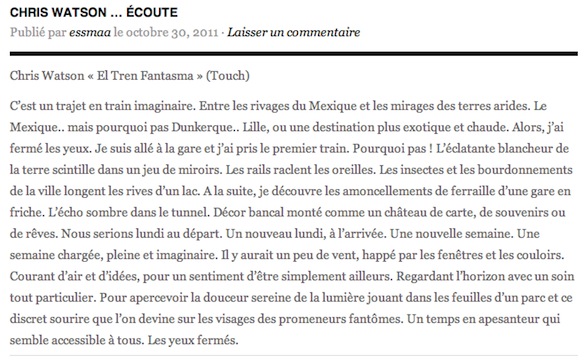
VITAL WEEKLY (Netherlands):
We know Chris Watson mostly from his works dealing with sounds from nature, animal wild life and stormy weather. A decade ago he worked as a sound recordist for the BBC who were doing a documentary on the Ferrocarriles Nacionales de Mexico, a train company with a trail from Los Mochis to Veracruz, coast to coast, through cities and wild life. All of that sound material is now used in ‘El tren Fantasma’, the ghost train (since it no longer exists). Now this is a truly fascinating CD. I liked pretty much everything I heard from Watson so far, but the mechanical sounds of the train, reminding of course of the very first composition of concrete sounds, ‘Etude Aux Chemin de Fer’ by Pierre Schaeffer, cut with sounds from the surrounding, makes this a highly narrative piece of music. Its perhaps I love traveling on the train (more than cars and planes), since you easily dream of watching the passing landscape, read a book, listen to music, and while not immediate train ride ahead, I’d be curious to hear this work by Watson on a train anytime soon.
Shifting from rusty mechanical train sounds and chirping birds and whispering insects, Watson paints a great sonic picture of the train ride. Very richly detailed sounds: one need only to close their eyes and the trip by train becomes a real trip. This is easily by far one of the best Chris Watson releases I heard so far. Not easy in the man’s catalogue of already great works, but this one surely is a masterpiece. Not just a collection of small great pieces, but also the overall narrative aspect of it. [FdW]
Titel (Germany):
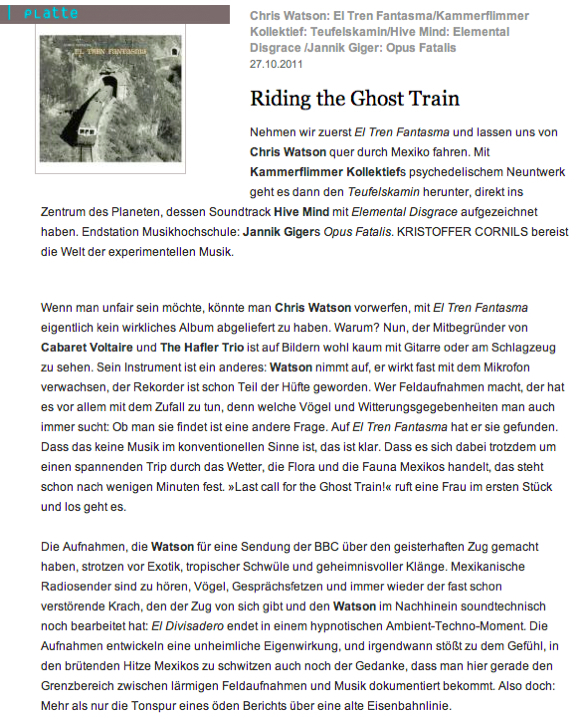
Chronicart (France):
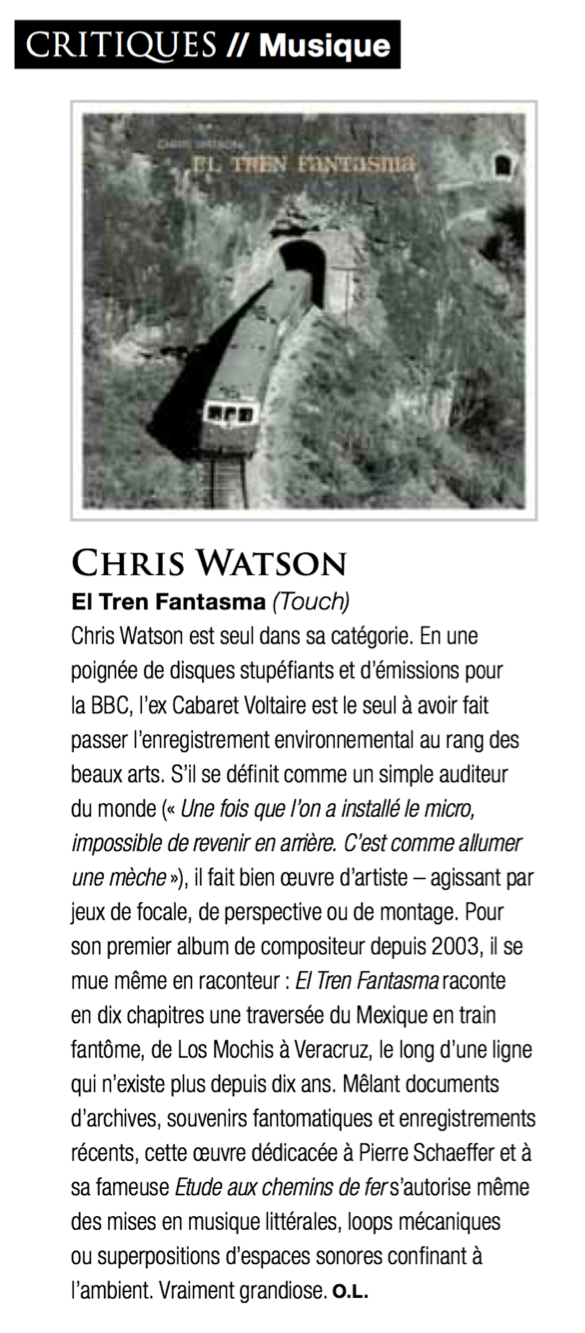
Brainwashed (USA):
Roughly ten years ago, BBC’s Radio 4 sent Chris Watson to Mexico to record one of the final continuous cross-country trips for Mexico’s passenger rail system. The resultant album is a narrative collage that uses those recordings to aurally recreate that unique and memorable journey. I’d definitely say he succeeded quite impressively at that specific technical objective, but that doesn’t necessarily translate into a great album.
El Tren Fantasma (“The Ghost Train”) borrows its title from a 1927 Mexican silent film, but it explicitly draws its primary inspiration from Pierre Schaeffer, whose train-based 1948 piece “Étude aux Chemins de Fer” was one of the first ever musique concrète compositions (unknowingly predated by only Halim El-Dabh’s “The Expression of Zaar”). A dedication to Schaeffer makes perfect sense here, as El Tren Fantasma is essentially an extension of what Pierre did in 1948, but with the benefit of modern recording and editing equipment. Sixty years of technological advances make an enormous difference though: Schaeffer was able to create a 3-minute rhythmic collage of train sounds, but Watson has condensed the sounds of an entire month-long journey into a single evocative and vibrant hour that doesn’t miss a single detail.
Obviously, the focus is very much on railroad sounds, but Watson also captures the ambiance of the various lonely stops along the way (right down to the insects and the breeze). Those touches are often among the album’s highlights, as Chris has a long history of expertly capturing the subtle sounds of the natural world. That said, Watson’s most impressive recording and editing feats are reserved for the train itself, especially the way the rumbling and clacking changes as the train goes over a bridge or plunges into a tunnel. Even when the nothing unusual is happening, however, the normal rumble and squeal of the train can be a striking and almost physical experience–especially with headphones.
Unfortunately, one of the album’s greatest assets is also perversely its greatest handicap: its vibrancy and immediacy. Watson has always created enveloping and amazingly life-like soundworlds, but none of his albums have been as bluntly attention-grabbing as this one: they just pleasantly and exotically changed my aural surroundings. El Tren Fantasma, on the other hand, demanded my complete focus, but once it had me, it never went as far or as deep as I wanted it to go.
That unexpected problem unexpectedly surfaced for me due to “El Divisidero,” a piece in which Chris unexpectedly moves from pure vérité into music by building a rhythm from heavily-processed clacking and weaving together something that sounds like a warm bed of droning synth. It isn’t spectacular or anything, but it made me wonder why Watson was willing to take those liberties, but didn’t go further and turn the trip into something increasingly strange and phantasmagoric. That would certainly make the album’s title seem more apt (though I understand that sounds disconnected from their source could also be perceived as “ghosts”).
Once I had that realization, it became very difficult to be content with an uneventful trip from station to station, no matter how perfectly rendered it was. Also, there is no denying the fact that a long train ride through Mexico cannot be movingly recreated without some sort of visual component. No one takes a train through Copper Canyon because they are eager to hear how it will sound.
While it is certainly relevant and necessary, it nevertheless feels a bit unfair to critique El Tren Fantasmo for the limitations of sound or for what I think it could’ve been. Chris Watson set out to do two very specific things: document the last days of one of the world’s most singular train rides and pay homage to one of electronic music’s greatest visionaries. He succeeded in both objectives beautifully. El Tren Fantasmo may not be a triumph of composition, but it is an unqualified masterpiece in the realms of both recording and sound editing. It is difficult to imagine a sharper and more instantly gratifying collage of field recordings than this one. [Anthony D’Amico]
Laif (Turkey):
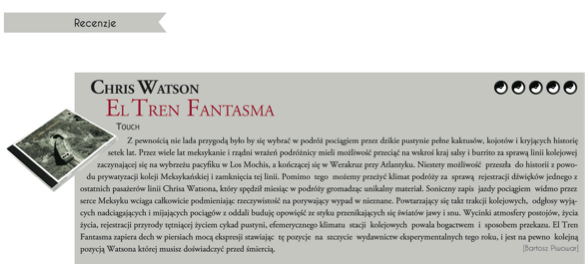
Whisperin’ & Hollerin’ (UK):
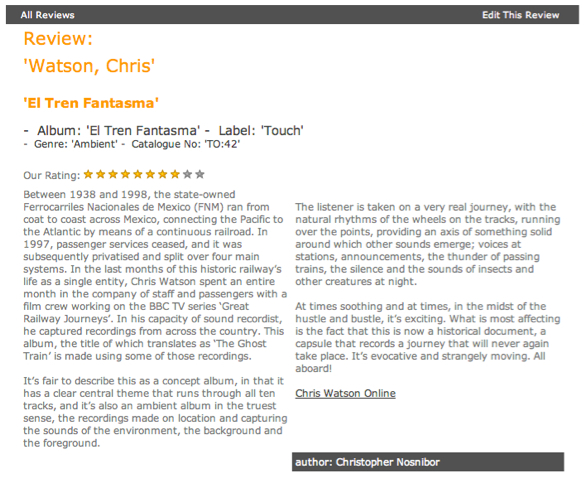
Dark Entries (Belgium):
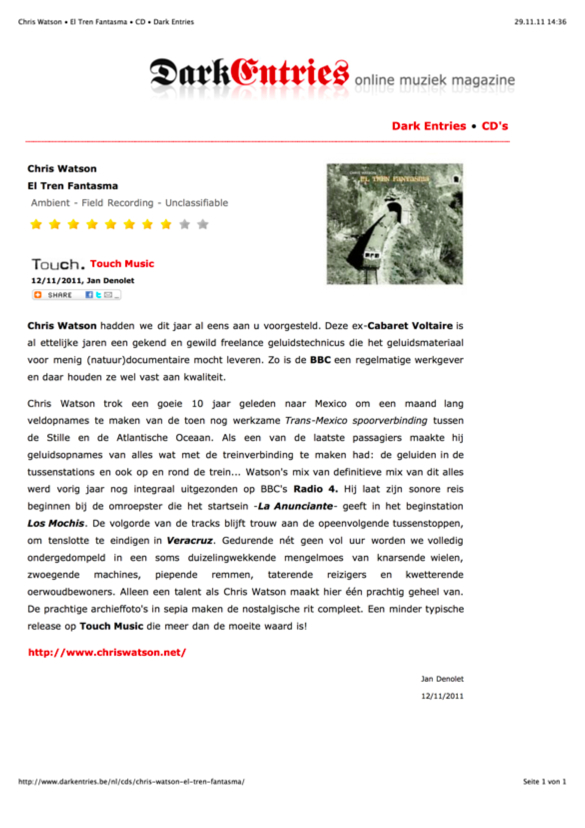
Debug (Germany):
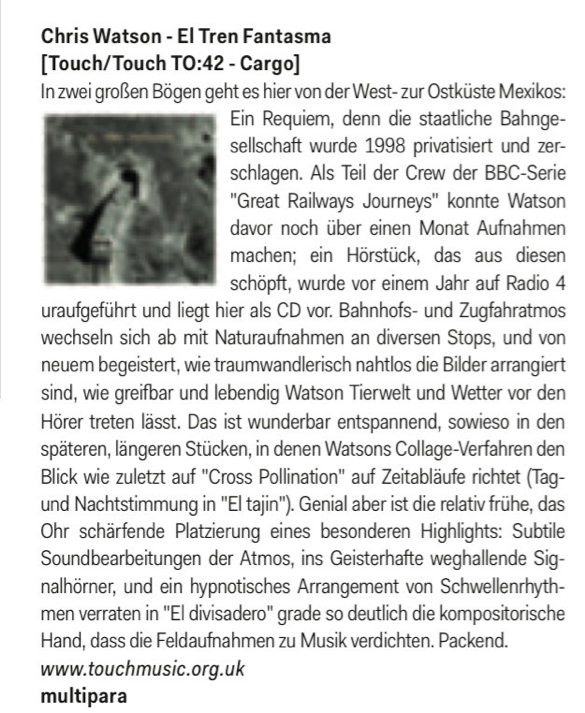
RifRaf (France):
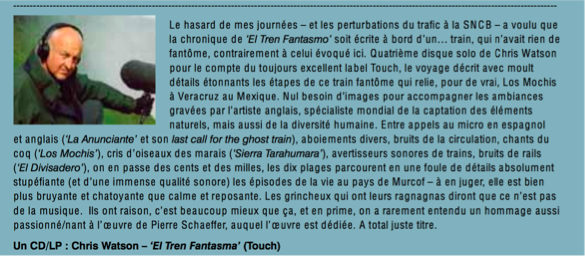
RifRaf (Belgium):
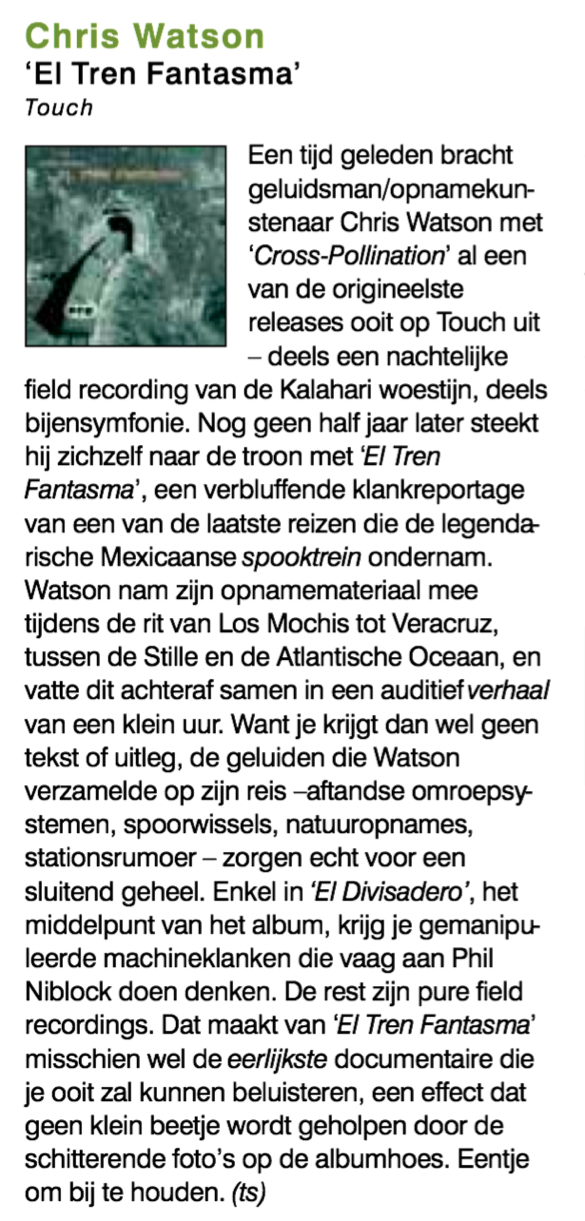
Sound of Music (Sweden):
”Inspired by Pierre Schaeffer” står det i den vackert formgivna digipacken som ramar in Chris Watsons fjärde album för brittiska Touch. En ganska given passning från dagens främsta field-recordings-artist till sin banbrytande föregångare. Det handlar naturligtvis om Pierre Schaeffers järnvägsinspelning ”Étude aux chemins de fer” som ingick i ”Cinq études de bruits” (ungefär ”fem studier i oljud”).
Men även om Chris Watson inspirerats av Schaeffer skiljer sig hans material radikalt från oljudsstudierna. I Chris Watsons hand är järnvägen inte något som för oväsen och gnisslar. Snarare handlar det om poetiska metallklanger som vävs samman med fågelkvitter, insekters surrande och andra djurläten längs järnvägssträckan. Då och då letar sig röster och radiomeddelanden in. Det låter verkligen inte vasst och metalliskt. Snarare varmt och drömskt.
Möjligen beror det på att Chris Watson återskapar en järnvägssträcka som inte längre existerar. Spöktåget går genom Mexiko, från kust till kust: det startar i Los Mochis vid Stilla Havet och anländer Veracruz vid Mexikanska Golfen. Denna sträcka lades ner för över tio år sedan. Men med Chris Watsons säkra arrangemang känns det faktiskt som att järnvägen och dess omgivningar får liv igen. Som vanligt låter han en hel ljudvärld strömma in genom sina mikrofoner och precis som vanligt är det obönhörligt fascinerande lyssning. [Mats Almegård]
The Wire (UK):

Radio France (France):
Le célèbre preneur de sons Chris Watson a traversé le Mexique en train d’ouest en est, du pacifique à l’atlantique pendant un mois pour enregistrer et recréer les sons d’une célèbre ligne aujourd’hui disparue, ceux des voyageurs, des villes et des paysages. Une impressionnante banque de sons que Watson a ensuite coupés, collés, agencés et mixés et recréer une aventure ferroviaire à travers le désert, les forets tropicales et les villes mexicaines. Pour qui aime voyager avec ses oreilles et laisser libre court à son imagination, cet enregistrement de très haute qualité est exceptionnel. Il est disponible en format CD, vinyle, mp3 et même en format flac (ce fameux codec de compression audio sans perte) au catalogue du label Touch. [Eric Serva]
Rumore (Italy):

Blow Up (Italy):

Electronique (Italy):
10/10
Una storia ambientata lungo i binari che collegano Los Mochis (piccola cittadina portuale che affaccia sull’Oceano Pacifico nel nord del Messico) a Veracruz (pari caratteristiche ma sul lato opposto dello stato, Oceano Atlantico), sono circa 1800 chilometri di binari serviti dai primi del ‘900 dalla FNM (Ferrocarriles Nacionales de México) ed ora praticamente in disuso, un tragitto che spacca nel mezzo il Messico, raccontando storie di povertà, sofferenza, emarginazione e quindi di fatto un amplificatore della quotidiana lotta di una nazione per cercare di sopravvivere ed evolversi.
A raccogliere i tremori di questo tragitto, il commovente lavoro di Chris Watson, artista che dopo aver praticamente sondato ogni forma di suono e contribuito al capitolo zero dei Cabaret Voltaire ha deciso di dedicare la sua vita a raccogliere i suoni generati dalla civiltà e dalla natura e che manca ormai con un lavoro solista su Touch dal lontano 2003, quando con Weather Report mise insieme tre lunghissimi brani con materiali raccolti in Kenia, Scozia ed Irlanda.
“El Tren Fantasma” è appunto uno spettro che torna per farci assaporare per una volta ancora un vissuto intenso e forse mai raccontato in questa maniera, attraverso registrazioni ambientali messe insieme con la sensibilità di un fotografo. Suoni che si materializzano in visione. Ascoltare questo disco ad occhi chiusi è forse il modo migliore per immedesimarsi in questo racconto tanto reale da far male.
Tutto ha inizio con “La Anunciante”, un megafono che annuncia l’ultima chiamata per il Tren Fantasma subito prima di chiudere le porte ed iniziare una traversata nei luoghi e nel tempo, totalmente rapiti dalla cura con la quale questi suoni sono stati registrati e soprattutto dall’approfondita selezione effettuata per far in modo che ogni singolo attimo catturato risulti come una sorta di oggetto vintage appena spolverato ed illuminato, per la sola durata del viaggio, da nuova vita. Durante il viaggio, il Tren Fantasma attraversa deserti, piccole comunità rurali, montagne e foreste, disegnando con calda precisione ogni scenario nei minimi particolari. La sensazione sarà proprio quella di ascoltare la colonna sonora per un film muto dei primi anni del ‘900. E forse una relazione in qualche maniera esiste anche, cercando bene in rete infatti spuntano undici minuti di riprese intitolate appunto “El Tren Fantasma” datate 1927 ma mai mensionate nelle info del disco, che invece ci tiene a metter per iscritto un “Inspired by Pierre Schaffer” uno dei padri assoluti della Musique Concrète.
Ripercorrerete questa tratta sudicia ed insanguinata sentendone addosso il respiro profondo e sospirando insieme ad essa, immaginandone i colori, gli odori e le sensazioni grazie al lavoro di un genio che ci regala un capolavoro imprescindibile di realismo sonoro. [liquid]
Sentireascoltare (Italy):
Ondarock (Italy):
Per Chris Watson vale la stessa regola utilizzata a suo tempo per Maurizio Bianchi: servirebbero molte parole e pagine per descrivere e raccontare l’estesa produzione musicale. In principio – come membro co-fondatore – fa parte dei Cabaret Voltaire, poi con gli Halfer Trio ed infine tutto in solitario. Figlio di quell’importante scena musicale inglese anni Settanta – che trova sfogo nella città di Sheffield (Human League, Clock DVA, Hula, etc) – riuscirà, poiché dotato di spiccata genialità, a prevalere su altri artisti. Oggi si può considerare, probabilmente, come una delle figure di riferimento per tutti quei neo artisti che intendono intraprendere e percorrere la cosiddetta non music e, più nel dettaglio, i field recordings.
“El Tren Fantasma” è un album pubblicato dalla storica etichetta Touch, e in sintesi si può definire come un minuzioso racconto – sonoro e non solo – di un viaggio in treno attraverso lo stato del Messico. Le registrazioni provenienti dalle cabine, i rumori degli scambi sui binari, i suoni d’interventi di manutenzione, le ganasce dei freni che premono sulle ruote metalliche e le note scandite dai passaggi a livello, rendono a tutti gli effetti reale quest’affascinante e misterioso mezzo di locomozione. Possiamo anche dire: “OK! I soliti field recordings”; e perciò la recensione teoricamente potrebbe anche finire qui ed in questa maniera. Ovviamente si scherza: è impossibile non accorgersi che in questo disco sono nascosti molteplici spunti, intriganti, enigmatici e tetri.
Cominciamo dal titolo dell’album: piuttosto che chiamarlo “El Tren Fantasma” (Il Treno Fantasma), forse è più appropriato definirlo come il treno dei fantasmi. Non tutti possono occupare un posto in carrozza. Questo permesso di salire è consentito solamente: agli spettri, quelle entità eteree che vagano sperdute fra il terreno e l’ultraterreno nell’attesa di ricevere finalmente un giudizio divino; ma anche a quelle persone che hanno la sensazione di sentirsi smarrite. Persone peccatrici e disperate; individui che hanno scelto il binario sbagliato o vittime di un deragliamento; uomini in cerca di risposte che siano in grado di soddisfarli, almeno nello spirito. Un percorso ferroviario lungo un’ora o poco più, e senza fermate intermedie. Due sole stazioni: quella di carico o di partenza (Los Mochis) – vedi copertina – può essere intesa come l’ultima porta d’uscita dalle tenebre e dai misteri; e una di scarico o d’arrivo (Veracruz). Questo capolinea rappresenta il luogo dove è possibile svincolarsi e redimersi da ogni forma di peccato.
Lo speaker – comunicando l’ultima chiamata per il ghost train – avverte e invita i viaggiatori ad accomodarsi in cabina; cavernosi noise accompagnano il lieve movimento del locomotore e l’uscita del treno da quel girone, profondo, oscuro e diabolico (“La Anunciante”). I primi segnali di luce si fanno sempre più frequenti. Il treno accelera la sua corsa provocando lunghe e incandescenti scintille di fuoco e acuti rumori, creati dallo sfregamento fra i diversi metalli costituenti e le rotaie e binari, creando così involontariamente atmosfere industrial e dark ambient (“El Divisadero”, Mexico D.F.”).
Non esiste un orario d’arrivo, infatti, il macchinista ad un certo punto sembra farlo rallentare (“Crucero La Joya”, “Chihuahua”): per tutti quelli che si sentono ancora inquieti e timorosi, bene, questa è l’ultima occasione per saltare giù e riprovarci la prossima volta.
Intanto, il vacante treno di ritorno, sfrecciando parallelamente ed in senso inverso, all’improvviso – con un potere detonante di mille megatoni – squarcia il silenzio che regna fra i sempre più ansiosi e impauriti viaggiatori (“Aguascalientes”). Siamo ormai quasi giunti all’arrivo. Un ultimo rallentamento nell’attesa di ottenere tutti i permessi d’ingresso, qualcuno riesce anche ad aprire un finestrino, e subito si è avvolti da eterei suoni ambientali e sentori floreali (“El Tajin”). Il treno è arrivato a destinazione nella irreale cittadina di “Veracruz”; che per una banale curiosità – scomponendo la parola (ver_a_cruz) e parafrasando dallo spagnolo – si può anche intendere come: vedere la croce?
L’atmosfera è solenne. Ora si è pronti per porre le domande e per essere giudicati. Contrariamente alla trama del racconto di Clive Barker – e del relativo film di Ryuhei Kitamura – intitolato “Midnight Meat Train”, dove i passeggeri del treno sono portati al cospetto del demonio per essere letteralmente mangiati, nel “El Tren Fantasma”, invece, il viaggio di questi individui è verso la salvezza e il divino. Il treno dei fantasmi – prendendo spunto dal quadro di Michelangelo sito nella Cappella Sistina – è come la barca di Caronte: il mezzo giusto per traghettare le anime perse e dannate verso dimensioni sconosciute e sovrannaturali.
Black (Germany):
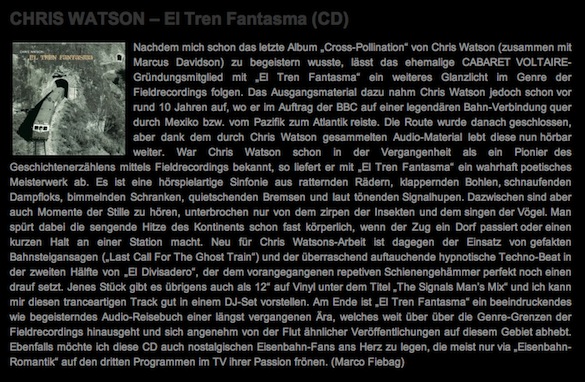
popmatters (USA):
Chris Watson, an ace sound recordist and co-founder of Cabaret Voltaire, spent five weeks one decade ago on a dying train line making a coast to coast trip across Mexico. He had a sleeping car at the back and the driver let him into the cabin, he recorded, he listened, he paid attention to the boom-boom of the rails, the intellect of the engine, and now he has assembled this one-hour musique concrète compression of the trip. The human presence is minimal, the rhythm is the rhythm of the journey itself, constant movement, constant change, a pulsing dynamo of change. Daytime peeps from birds come early on, then nighttime insects near the end, first waking up the album then putting it to sleep, and finally there is the kraw-kraw of a graveyard crow, presaging this rail-line’s shutdown, which came soon afterwards. A thunderstorm arrives. Watson’s train is not an abstract object, it feels its way through a landscape of animals and elements. Brilliantly textured, brilliantly sensitive, unrepeatable by its very nature—this is a great example of a sound recordist’s art, like the uncanny soundtrack to a very solid dream. Rating: 9 out of 10 [Deanne Sole]
Basatap (Turkey):
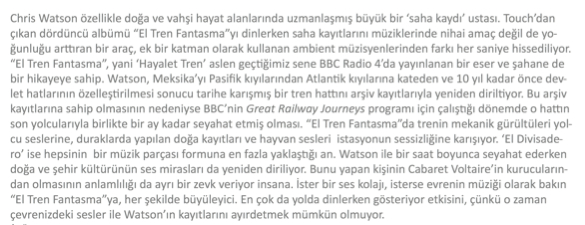
Derives (Belgium):
Each Chris Watson release is a mystery, through which finally you realize you are using just a small part of your hearing, and so it is stimulating as you’re taken as passenger and listener of his own quests and explorations.
He is not someone pretending to a career or to a reputation through his record, and his record are always a conjunction of both attraction and elaboration of soundscapes through the use of field recordings.
On “El Tren Fantasma”, he reinvents a train travel from West coast to East coast, from Los Mochis to Veracruz, all through Mexico, a rail passenger service which no longer exists since more than a decade.
Chris Watson was lucky to spend a month on board the train with some of the last passengers to travel this route before it stopped. Using these archive recording he recreated here, ten years after, a “ghost train” including the whole atmosphere of the area, through wildlife and human life, with the sound of rails and sometimes fragments of piano melody as interludes.
It starts with “La Anunciante” and the pure sounds of trains crossing a station, with announcements and a deep reverb typical to such vast places, with an oneiric dimension as the whole trip is finally just a fantasy. Roosters singing, the sound of birds, temporary distorted distant sounds of a radio, a dog barks, the rising sound of motors, of machines and finally the deafening locomotive who enters the station, the unloading and loading and then we starts the trip, slowly entering its monotony until the dying notes of a vinyl playing a piano song.
Next we’re crossing the rocky mountains area of the “Sierra Tarahumara” and Chris Watson just keeps the train as a distant presence, focusing mainly on the environment wildlife and sounds of wind, which are finally his trademarks. At “El Divisadero”, the sound of trains are like a water stream, through a succession of small, more and more echoing waterfalls, with above in the sky, the menacing figure of a bird of prey.
Irritating flies, and a powerful sun, around noon, on “Crucero La Joya”, all you wish is a shelter, no sounds from the train, and suddenly and comforting short piano melody.
A railroad through tunnels and bridge, “Chihuahua”, mechanic sounds from above the train, between two wagons. With “Aguascalientes”, it’s on the contrary like listening to a distant train coming closer and closer and finally riding at full speed just in front of you with a deafening and shocking effect.
On “Mexico D.F.”, it’s like he recorded trains inside of their network of tunnels. Cicadas and the quietness of rainforest on “El Tajin”, a stroll around the archeological site, with later the sound of a distant train as a temporary background drone. Finally the scenic, almost orchestral arrival in “Veracruz” ends the journey.
Playground (Spain):
Durante años, una línea regular de ferrocarril había conectado las dos costas de México, la atlántica y la del océano Pacífico, y transportaba viajeros de una punta a otra del país, de Los Mochis a Veracruz. Desde hace una década, y por decisión irrevocable de la FNM (Ferrocarriles Nacionales de México), esta línea no existe y el tren que pasa por ella –es decir, el tren que no pasa– es ‘el tren fantasma’. Sin embargo, Chris Watson tuvo la oportunidad, durante un mes, de viajar de este a oeste de México, y viceversa, antes del cierre de la línea y pudo grabar sus sonidos, tanto los del vagón como los del trayecto y los alrededores. Watson es un audio-artista que no necesita presentación para quienes consumen habitualmente música de los ‘outer limits’ –ex miembro fundacional de Cabaret Voltaire y The Halfter Trio, desde 1996 dedicado en exclusiva a la grabación de álbumes de field recordings en paralelo a su otra actividad, la de registro de sonidos para documentales de la BBC, tanto para radio como para la televisión–, y por tanto no tiene que extrañar que esta sinfonía espectral de sonidos de la naturaleza demuestre semejante aplomo. Es, además, un pequeño acontecimiento, pues se trata del primer álbum que firma Watson para Touch desde 2003 –sin contar colaboraciones ni trabajos en otros sellos–.
El instrumento de Watson es el micrófono de alta precisión, es un virtuoso en la captura de instantes únicos –ya sean animales en la vida salvaje como en “Outside The Circle Of Fire” (1998) como la variedad de emisiones de la naturaleza virgen en “Weather Report” (2003)–, y “El Tren Fantasma” no es una excepción. Todo el material utilizado por Chris Watson en este álbum tiene más de diez años de vida, de cuando la ruta todavía existía y fue enviado por la BBC a grabar para un episodio de una serie sobre grandes trayectos ferroviarios del mundo. Pero esto no es sólo una colección de ruidos y voces, a pesar de que en el fondo se esconde un homenaje a la música concreta y, en particular, al padre Pierre Schaffer, a quien está dedicado el disco clarísimamente en alusión a su pieza “Étude Aux Chemins De Fer”, la fundación de todo el género en 1948. Lo que es esto es una recreación, desde la ausencia y desde las huellas que ha dejado el paso del tiempo, de un viaje desde Los Mochis a Veracruz simulando que estamos en el vagón escuchando en silencio todo lo que sucede durante el viaje. “La Anunciante” se compone de los avisos por megafonía a los pasajeros y el trajín de maletas y pasos, “Los Mochis” es el arranque del tren y las sucesivas piezas se centran en zonas de tránsito, próximas estaciones con parada –“Chihuahua”, “Aguascalientes”, “Mexico D.F.”–, hierro rotando sobre hierro –o sea, el girar de las ruedas sobre el riel, el ‘metal on metal’ de Kraftwerk llevado a su extremo más naturalista– y sonidos de la selva y el mar. Durante 65 minutos no se diría, además, que sólo se está escuchando sonido ambiente: Chris Watson sabe organizar cada fuente para crear dinámicas rítmicas, drones hipnóticos e incluso amagos de melodías como en la sinfonía de mosquitos de “Crucero La Joya” y, al final del trayecto, “El Tren Fantasma” queda como una experiencia a medio camino entre el desconcierto y la fascinación, alucinante en sus mejores momentos y misteriosa casi siempre (además de una aportación interesantísima a ese subgénero de la música grabada conocido como ‘discos sobre trenes’). [Robert Gras]
Skug (Spain):
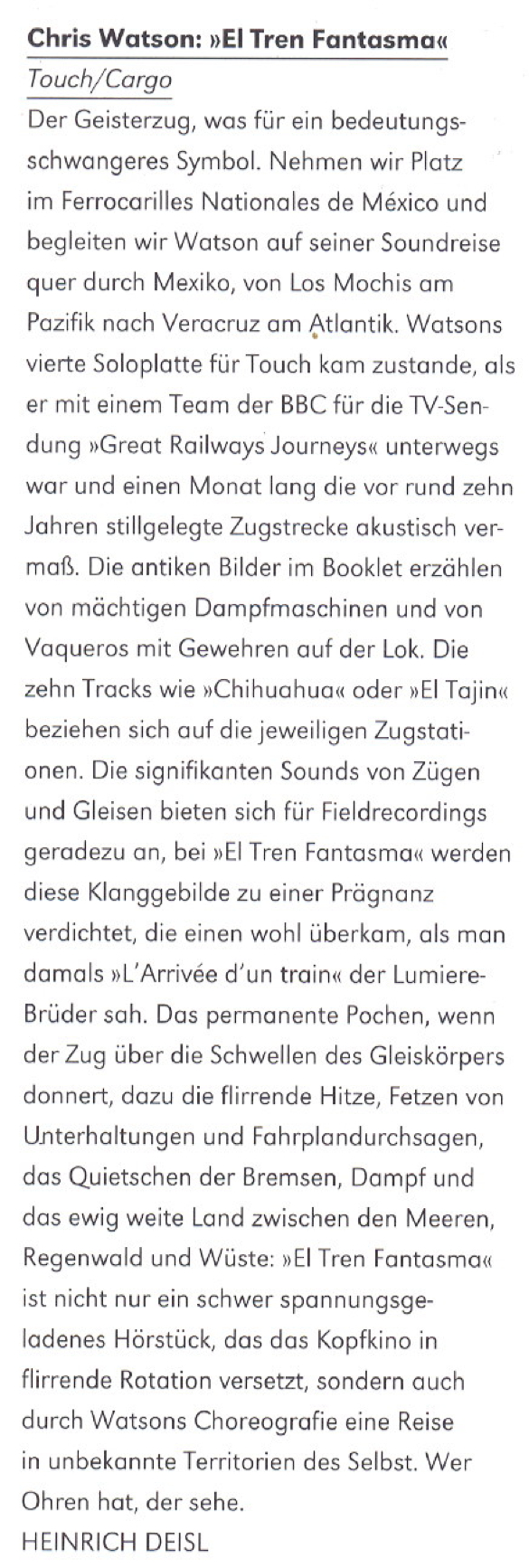
Gomag (Austria):
<img src=”https://touch33.net/archives/reviews_chriswatson/gomagto42.jpg”>
Dusted (USA):
Eric Dolphy famously said, “When you hear music, after it’s over, it’s gone, in the air. You can never capture it again.” It’s a poetic statement, but in some ways, he was quite wrong. Dolphy left us way too soon, and while we don’t have him playing in the same room with us, I’m sure glad he left some recordings behind. El Tren Fantasma likewise brings back the sounds of something that has passed and makes them meaningful now.
Chris Watson (ex-Cabaret Voltaire and Hafler Trio) is the dean of environmental recording; his previous Touch releases include compelling audio experiences constructed from the captured and rearranged sounds of bees, storms, vultures and icebergs. The events that yielded those sounds are long gone, and so it is with the source recordings of El Tren Fantasma. Watson obtained them over the course of a five-week residency he spent in the late 1990s aboard a train slowly traversing Mexico from Las Mochis to Veracruz. The line was about to close down, and in honor of its impending demise, the railroad pulled some old engines out of mothballs and permitted an episode of the BBC documentary Great Railway Journeys to be made about it. Watson supplied the audio for that episode (although not the available YouTube clips, which arbitrarily combine some other audio with the documentary’s footage), and now, over a decade later, he’s made his own music from the dead voice of the Ferrocarriles Nacionales de México.
You might think it a stretch to call recordings of moving trains, station announcers, trackside wildlife, and the passage of breezes through trees “music,” but Watson is no mere documentarian. He captures (or enhances) sounds in three dimensions, and the way he arranges them invites both immersion and reflection. You can marinate in the rich variety of non-human sounds – wind and insects and birds – that you might be able to listen to all day besides these now-disused tracks. You can ponder the relative smallness of human presence as a whistle sounds in the distance, or crank up the hi-fi and get bowled over by the clatter of wheels on tracks. You can dig the clickety-clack groove, or find poetry in the sounds’ suggestions. Only once, on “El Divisidero,” does Watson process the sounds to hint at instrumental play. But throughout you can perceive the composer’s hand, and consider our fortune that he snatched these sounds out of the air and brought them to us. [Bill Meyer]
Cyclic Defrost (Australia):
Chris Watson, after the flurry of virtuous riot that was Cabaret Voltaire, stepped sidewards into a second career with the BBC as a sound recordist for documentaries. While such an occupation opened up the area of field recording, specifically with the focus on nature documentaries which heighten the sense of ambient noise as a major part of the form, it also allowed for some adventures in experimental sound design. The very focus of the recording, naturally occuring sounds, and the manipulation of these recordings using electroacoustic techniques is a development from Musique Concrete, specifically the work of Pierre Schaeffer to whom Watson dedicates this work. Even if you obscure the musical form and look at subject, comparisons could be drawn to Kraftwerk’s Trans Europe Express, Banco De Gaia’s Last Train to Lhasa, Lee Scratch Perry’s Train to Doomsville, FUSE’s Train Tracks, or even KLF’s Last Train to Tanscentral. However most of these are trains as metaphors or vehicles for placement of musical and arcane obsessions into a document. Watson’s work is more a comprehensive analysis of the variety of sounds extracted from an experiential journey, historical documentation and geographical place placed into an artistic frame that is both reflective and formative of contemporary sound art.
El Tren Fantasma, (The Ghost Train) collates sounds gleaned from the production on BBC television series Great Railway Journeys on board the Ferrocarriles Nacionales de México (FNM). So while it has aspects of the documentary style of accurate portrayal, a bringing of the subject to the distant audience, the form of armchair tourism, it quickly displaces these expectations with the sonic distortions and heightened realities of particulars. ‘La anuciante’ opens the album and draws together the boarding call, whistle, steam, station ambiance, train breaking and shunting sounds but also takes sounds of the tension of metal on metal, of the train’s progress and extends through effect into drones and the journey into the industrial environmental faux documentary begins. ‘Los Mochios’ takes a bucolic dawn and warped Mexican folk music to restart the journey, from the cockerel cries and dog barks to the level crossing, stream breaks and then it is all concentration on the rhythmic tension available from the engine and the sound of metal on metal of the wheels. It is a spatial document to some degree as the aspects of sound approach dimensionally and it is this clear separation and construction of place that both insinuates your mind in the idea of it as an authentic document as well as it’s absolute implausibility, dead set simulacra and utilisation of an idea for effect.
‘El Divisadero’ brings on the extended drone aspects to full flight, where it extracts long harmonics from sounds and contrasts it to the trance like track effects, moving into burbling effects elicited from sonic manipulation of the same sounds and then entering into a drum pattern playing against the sound of the wheels in conversation. There are more subtle constructions, ‘Aguascalientes’, provides the long sound of approach, passing and departure of the train with the heightened effects added for a sense of psychodrama. ‘Mexico D.F.’ extrudes sounds and conveys almost the night of the journey, a conglomeration of slow rhythms and low sharp drones starkly placed against each other, rumbles and echoes that elicit a weary dread only given respite by a brief station stop mid track. ‘El Tajin’ lightens the mood with it’s early morning chorus and concentration on high tone aspects, insect and bird calls and gradual integration of a distant locomotive presence. ‘Veracruz’ beginning with the siren call finishes the album, bring together the more dynamic aspects of the train motion, fusing the hint of epic drones to the layered motion and spatial effects. The horn sounds the beginnings of immanent aspects of travel and the rhythm is insistent and pacy, moving insistently towards the exit announcement.
The thrills of this album are accumulative with repeated listening and it’s appeal is generally for those who are keen on immersive environments and sound art experiments. The ideas of the musique concrete, field recording, cultural archiving and immersive industrial environments are encapsulated in an extreme contemporary frame.
[Innerversitysound]
GMD (France):
« Última llamada para el Tren Fantasma. » Voilà le point de départ d’un disque qui ne ressemble à aucun autre. L’histoire d’une ligne de train – El Tren Fantasma donc – aujourd’hui désaffectée, et qui avait pour particularité de relier le Mexique d’ouest en est, de la côte pacifique à l’Atlantique. Mais ce disque, c’est aussi et surtout l’histoire d’un homme, mais également celle de tous les hommes dont cette ligne était le quotidien jusqu’à il y a peu. Cet homme, c’est Chris Watson, ancien membre de Cabaret Voltaire reconverti en ethnologiste rigoureux. Si on le retrouve au cœur de nombreux reportages animaliers de la BBC, c’est sûrement parce que l’Anglais est le chef de file incontestable en matière de field recording, de capture de sons environnementaux. Son dernier disque – Weather Report – constituait jusqu’à présent l’une des plus grandes œuvres du genre. Avec El Tren Fantasma, Chris Watson va encore un peu plus loin, et explose littéralement la frontières entre capture sonore et sound design.
Du voyage entre Los Mochis et Veracruz ont été tirées des séquences entières de bande sonore, réduites à une heure. Cette contrainte temporelle induit forcément le choix des ambiances, des couleurs, des arrangements. Il y a donc, qu’on le veuille ou non, composition. Les sons environnementaux – bruits de rails, freinages, vents sur la broussaille, animaux, jusqu’à la vie des populations locales – se superposent et s’organisent dans un magma qui tient autant du film dramatique que de la composition électro-acoustique. El Tren Fantasma c’est une heure au cœur-même de la vie de milliers de Mexicains. Pas ceux que vous pouvez apercevoir dans les pubs pour les Pepito, mais ceux qui se lèvent tôt pour traverser des jours durant un univers désert et hostile. Une aventure où tout se ressent, où tout se décrit au plus proche de la réalité. On n’est pas ici dans une vague tentative de cinéma altermondialiste foireux – on laisse ça à Manu Chao et à Florent Pagny. Ici, le son est capté avec une telle précision qu’on nage en permanence dans le sound-art, celui-ci n’étant rien d’autre que la plus instinctive expression d’un milieu naturel.
On ressent ce périple jusqu’à la poussière qui vous empêche de dormir, jusqu’à la chaleur écrasante qui vous coupe le souffle et vous fait suer comme un pain saucisse. Ce Mexique-là fait parfois peur, de nuit souvent, mais il se vit comme des milliers de vies mises bout à bout. Et puis il y a cette agencement de sons, cette manière de traiter le matériau brut comme le point de départ d’une démarche qui s’inscrit inévitablement dans la lignée des musiques concrètes – le matériau concret précédant toujours l’effort abstrait, à l’inverse du schéma traditionnel. La bande sonore s’impose – et restreint dès lors. C’est au musicien de tester les limites, de réarranger pour passer du spectateur à l’acteur. Une dimension poétique viscérale quand on sait que les enregistrements d’El Tren Fantasma sont l’expression même de la liberté. L’exploration comme contrainte de l’œuvre, et pourtant de l’autre côté, la clé de la totale création musicale. Le trip ultime. Chris Watson pose ici son chef d’œuvre. Les mots d’Andrew Weatherall n’ont jamais sonné aussi justes : “A benchmark in field recording not to mention a map of the soul, an insight into the human condition and a key to dreams.” [Simon]
Le Son du Grisli (France):
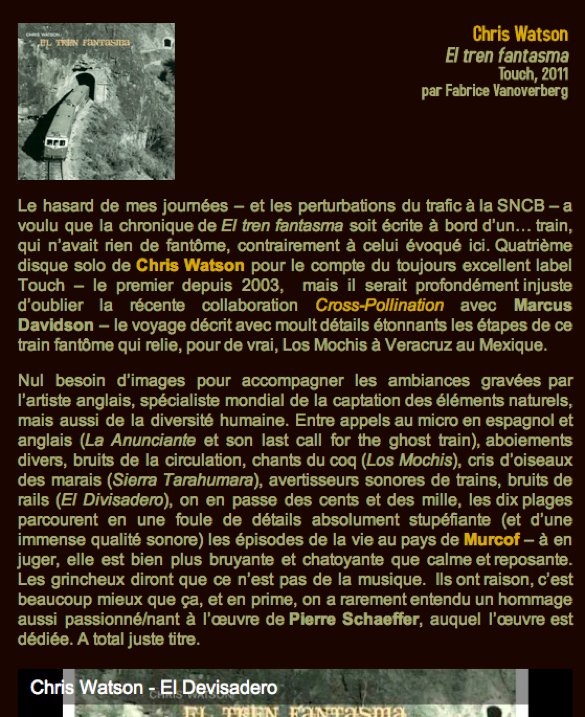
Trust (Germany):
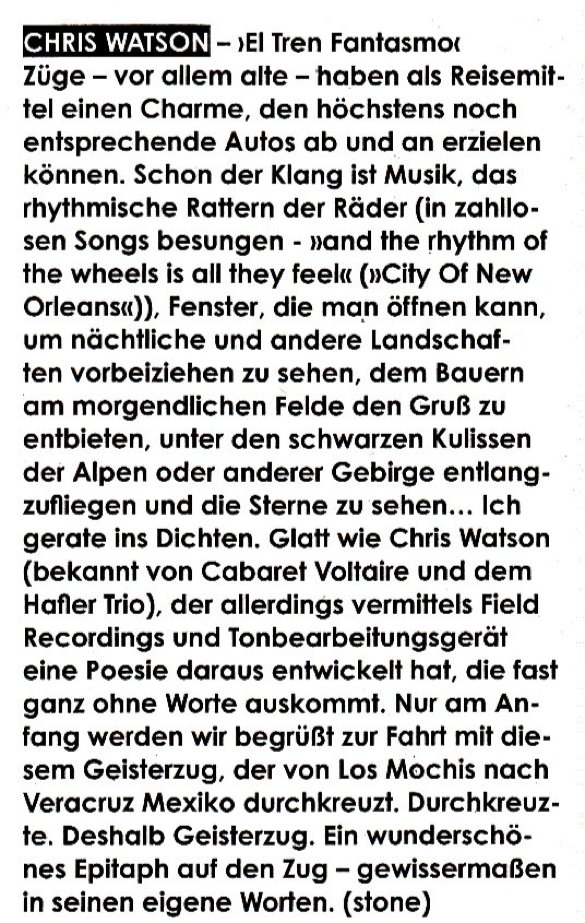
Radio Student (Slovakia):
Konec minulega leta je britanski specialist za terenske posnetke objavil novo izvrstno ploščo, s katero je tokrat ‘dokumentiral’ svoje mehiško popotovanje s pacifiške do atlantske obale … (v celoti!)
* Glasba nas danes spremlja na vsakem koraku. To zelo dobro ve tudi britanski zvočni umetnik Chris Watson. Razlika je le ta, da on glasbo sliši tudi takrat, ko je povprečen poslušalec ne sliši več. Če je ne sliši s prostim ušesom, svoj mikrofon potisne v truplo zebre v afriški savani, globoko v arktično morje ali pa v vrhove smrek v italijanskih Alpah. Ob poslušanju njegove nove plošče se pojavi vtis, da je mikrofon tokrat potisnil v svoje počitnice. Z zvokom je namreč dokumentiral svoje popotovanje od pacifiške do atlantske obale v Mehiki. Ker je potoval z vlakom, se plošča ’El tren fantasma’ sliši kot nekakšen terenski techno album. Ritem narekujejo spoji tračnic in hidravlika lokomotive, melodični nastavki se opirajo na zvok siren in zavor, atmosfero pa krojijo ljudje na postajah, živali ob progi in vremenski pojavi. Iz zvokov, ki jih povprečni popotnik/poslušalec morda ne bi niti opazil, je Chris Watson ustvaril še eno ambientalno mojstrovino.
Ločnice med zvokom in glasbo Watson briše že od sedemdesetih let minulega stoletja. Takrat še kot član sheffieldskih industrial in elektronskih pionirjev Cabaret Voltaire, pozneje tudi kot polovica dvojca The Hafler Trio. Vselej ga je zanimala tista bolj ekstremna, mejna izraznost, v kateri se razlike med glasbo in zvočno umetnostjo raje skrivajo kot razkrivajo. V zadnjih letih je bil znan predvsem kot snemalec zvoka za BBC-jeve dokumentarne oddaje, sporadično pa je objavljal tudi avtorske plošče, med katerimi jih kar nekaj obeležuje vrhunce terenskih posnetkov.
Watsonova metodologija je bila vselej precej radikalna. V nasprotju s sorodnimi ustvarjalci, ki so terensko nabrane posnetke pogosto studijsko zmanipulirali v nerazpoznavne nove zvoke, je Watson vselej ohranjal izvirne, neobdelane zvoke. Posamezne zvoke je pogosto le izčistil in amplificiral ter jih logično uredil v kompozicije, ki so kar najbolj nepristransko dokumentirale posamezen kontekst, kader ali pa sekvenco iz narave. Njegov album ’Weather Report’ denimo velja za enega najlepših dosežkov skozi prizmo ambientalne glasbe in terenskih posnetkov.
Svojega pristopa ni spreminjal niti pri plošči ’El tren fantasma’. Večina skladb je še vedno oprta na izvirne, na terenu zbrane zvoke, med katerimi so mnogi že postali nekakšen Watsonov zaščitni znak. Še več, v zbiranju in urejanju zvokov iz okolja je bolj avtorski kot številni ustvarjalci, ki zvok krojijo povsem neobremenjeno. Toda v primerjavi s preteklimi solističnimi ploščami je šel Watson tokrat še korak dlje. Posamezne, predvsem nizkofrekvenčne zvoke, je studijsko zmanipuliral v prave male simfonije, ki bolj kot naukom terenskega snemanja sledijo digitanim dronerskim trendom. V nekaterih skladbah se tako denimo zelo približa estetiki Geira Jenssena alias Biosphere, ki je umetnost spajanja terenskih posnetkov in sintetičnih zvokov razvil v morda najbolj popolno obliko. Watson s ploščo ’El tren fantasma’ sicer ostaja bolj antropološki, toda obenem na njej odpira tudi neko – da, metafizično izkušnjo. Fantomski vlak pač. [Goran Kompoš]
Musicworks (Canada):
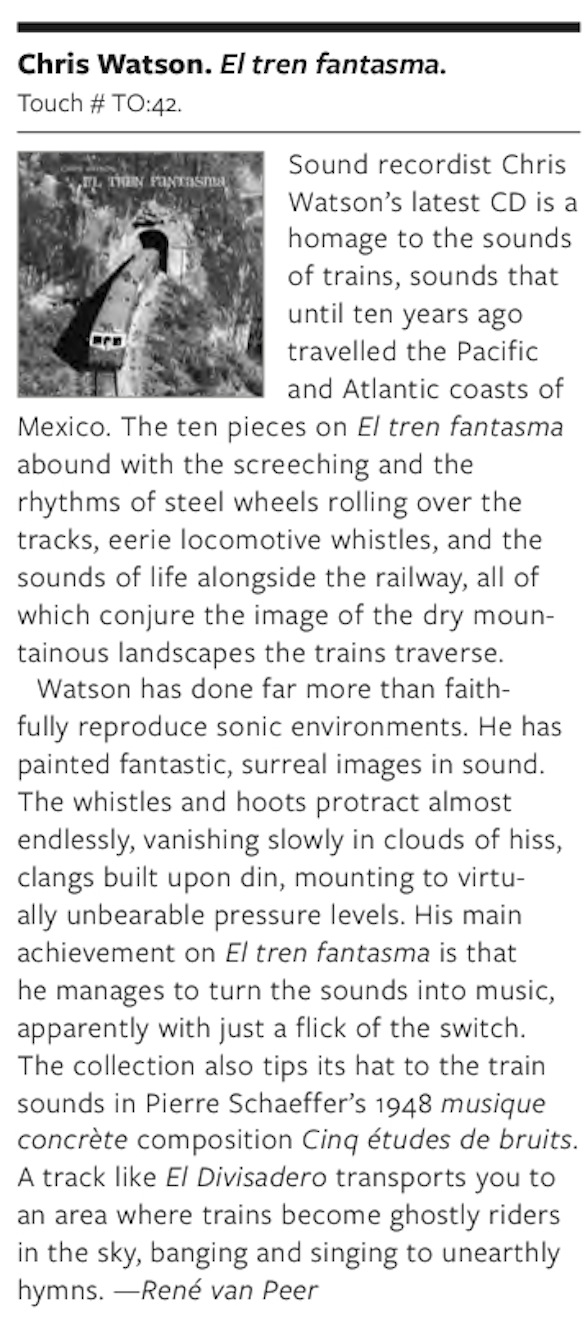
Terz (Germany):

Lidove Noviny (Czechia):

headphone commute (web):
I begin the journey of El Tren Fantasma at the station, as the announcer calls out the “last call for the ghost train”. The train enters a dark tunnel and I drift away with a rhythmical beat of the wheels falling into the spaces between the old tracks. These sounds remind me of my childhood, when I traveled by train to visit my grandparents for the summer. I arrive in the Mexican village, where the birds chirp and the roosters crow, as the train screeches to a halt somewhere in the heart of the country between Pacific and Atlantic coasts. My ears are awake, picking up on the sounds of the trees talking to each other in the wind, butterflies dismissing the air with their conceded flapping, and the woodpecker’s cryptic beat. The train moves on, and soon its rhythm turns into a soothing pulse, slowly hypnotizing me as I drift in and out of dream state.
Using archive and field recordings, Chris Watson recreates a passenger ride across the country on a line that no longer exists. It’s been more than a decade since the last service operated by the Ferrocarriles Nacionales de México (FNM). Watson spent a month on board one of the trains as a sound recordist working with a film crew documenting a BBC TV series on Great Railways Journeys. The atmospheres captured with sensitive microphones in the country reveal the environment at its most open, intimate and natural setting. An additional post-production of looping train samples, turns this mere field recording into a mesmerizing trip. This is more than just a sound portrait lifted off a television show. Watson composes a cinematic narrative bringing the listener (and the observer) into a setting unattainable alone.
“Take the ghost train from Los Mochis to Veracruz and travel cross country, coast to coast, Pacific to Atlantic. Ride the rhythm of the rails on board the Ferrocarriles Nacionales de México (FNM) and the music of a journey that has now passed into history.”
El Tren Fantasma is a fourth solo album for Touch by one of the world’s leading sonic archivists of wildlife and natural history. Watson’s 2003 album for the label, titled Weather Report, was named as “one of the albums you should hear before you die” by The Guardian. Watson is a seasoned veteran of sonic architecture. In 1971 he was a founding member of Cabaret Voltaire as well as The Hafler Trio (this is before he left Andrew McKenzie to release his collaborations with Autechre, like æo³ & ³hæ). In 2011 Watson also collaborated with Marcus Davidson on Cross-Pollination (see Headphone Commute review in Sound Bytes : Touch Label Special). And there’s also a 2-track 12″ pressing of El Tren Fantasma: The Signal Man’s Mix. My childlike fascination with trains and the sounds evoked by El Tren Fantasma invite me to listen to the album over and over again. And when you hear this magnificent recording, you will surely agree…
Liability (France):
Curieux qu’on puisse dire que Chris Watson n’a pas donné de nouvelles depuis huit ans. Depuis Weather Report, Watson a sorti au moins deux albums sous son nom (Cime Verde et A Journey South) et d’autres en collaboration avec Alec Finlay, KK Null, Z’ev, Jana Winderen et Marcus Davidson. Pas moins de six albums au total et un split avec BJ Nilsen. Ce n’est pas mal pour quelqu’un qui n’est pas sensé donner de nouvelles depuis un certain temps. Ceci étant, je suis d’accord avec mon collègue de Chroniques Electroniques (qui ferait bien de mieux lire les notes de presse qu’on lui envoie) pour dire que ce nouvel album de l’ex-Cabaret Voltaire est un chef d’œuvre. Depuis qu’il a quitté Cabaret Voltaire, Chris Watson s’est spécialisé dans le field recordings et s’est révélé être l’un des plus beaux sculpteurs sonores de se génération. Il n’est pas forcément le plus connu dans sa partie mais il force le respect rien qu’à entendre son nom.
Pour El Tren Fantasma, il s’est penché sur le monde ferrovier, collectant les sons du chemin de fer mexicain, de ce qui l’entoure et les a rentransformé au gré de ses propres fantasmes. Le travail de traitement des différents sons, leurs cheminements, les options constructives prises par Chris Watson sont tout à fait remarquables. On se rend alors compte qu’au delà de la stridence de certaines sonorités il y a aussi une rythmique, celle des machines, celles du frottement entre les rails et les wagons. Et tout autour de tout cela il y a la vie, foisonnante, ruisselante et chaleureuse. Ici, cette vie se confond avec l’engin de métal. Ce dernier fait partie des habitudes de l’homme, il lui est familier au point qu’on ne fait plus forcément attention à sa musicalité. Chris Watson propose une reconstruction où des textures électroniques s’invitent comme éléments liant le monde vivant et celui des machines. Il n’est sans doute pas le premier à y avoir pensé mais il est surement l’un de ceux qui a le mieux su s’y prendre. Justesse, équilibre et mise en relief, tels sont les impératifs de ce disque qui transpire une poésie fantasmagorique. Lucien Bertolina avait déjà tenté l’aventure ferrovière (Cœur de fer – L’empreinte Digitale, 1993) mais Chris Watson est clairement un bon cran au-dessus.
Etherreal (France):
roisé l’an dernier aux côtés de Marcus Davidson, Chris Watson nous revient en solo avec la version disque d’un concert qu’il donnait lors de l’édition 2011 du festival Présences Électronique. On se souvient bien de ce concert qui nous avait passablement ennuyé, en particulier avec ses voix off faisant office de guide touristique. Qu’en est-il alors de la version enregistrée ?
On en retrouve clairement l’esprit, le son aussi bien sûr, mais tout ce qui nous avait gêné lors du concert, à commencer par ces voix documentaires, semble avoir disparu.
Mais commençons par replacer le contexte : il y a une dizaine d’année, la compagnie ferroviaire mexicaine mettait fin à un service régulier traversant le pays d’ouest en est, de Los Mochis à Veracruz en passant par Mexico. Durant les dernières semaines de trafic, une équipe de la BBC était sur place dans le cadre d’une série documentaire sur les grandes lignes ferroviaires. Dans l’équipe de tournage se trouvait Chris Watson, alors responsable de l’enregistrement sonore. Pendant un mois il sillonna le pays, de gare en gare, de villes en villages, captant l’esprit du voyage, la faune locale, les modes de vie.
Comme bien souvent avec l’anglais, et à l’image du film produit par la BBC, nous sommes dans le domaine du documentaire. On embarque avec lui, une annonce confirme que l’on est dans le bon train, les portes claquent et on se laisse bercer par un jeu de chuintements, de souffles répétitifs du grincement des rails et des freins.
Chris Watson nous propose de faire le voyage d’ouest en est, chaque piste portant le nom d’une gare dans laquelle on s’arrêtera. On commence ainsi par la paisible ville de Los Mochis avec le chant d’un coq, le piaillement des oiseaux, la musique sortie d’un vieux poste de radio, un chien qui aboie et les machines qui se mettent en route, le bruit lourd d’une locomotive. On est souvent perdu en plein désert, bercé par le chant d’oiseaux exotiques, d’insectes qui semblent tourner autour d’une charogne, le souffle du vent. On imagine les cactus autour de nous, une tempête de sable qui se lève (Sierra Tarahumara, Crucero La Joya, El Tajin ; El dia y La noche) avec pour seule trace de civilisation la sonnerie d’un passage à niveau.
A l’approche des villes, le son est plus dur, industriel, marqué par les machineries, l’ambiance d’une gare avec ses va-et-vient, les freins grinçants et les claquements métalliques que l’on associera aux portes d’un wagon de marchandise (Chihuahua).
Mais sur les 10 pistes qui composent ce disque, on en distinguera une en particulier, un peu différente, plus éloignée du documentaire. El Divisadero débute par un grand coup de klaxon qui se dilue en une douce nappe, puis c’est le claquement des rails qui forme une véritable rythmique. Nappes et drones habillent le tout et forment le titre le plus “musical” de l’album, à la manière d’une ambient concrète.
Nous qui n’étions pas convaincu par le concert de Présences Électronique, nous voici conquis par cet album à la fois documentaire et narratif. Une invitation au voyage.
Musique Machine (UK):
Chris Watson is a familiar name in field recordings, if not the most familiar name. Despite crossing paths with his work on several occasions, this is the first full album I’ve actually heard – and it doesn’t disappoint. Its packaged in a smart digipack, with vintage photographs of its subject matter: trains and their journeys from Los Mochis to Veracruz, in Mexico. The ten tracks within “document” this journey, using sounds recorded on that journey.
As would be expected, train sounds dominate the recording: trains screeching, rattling, braking and clattering along. But there are also plenty of sounds from the surrounding elements of the environment: birds, insects, people, radios, ambient sounds; it is a somewhat limited palette, but this does give the album a real focus and identity. These sounds are layered and collaged by Watson, to evoke a sense of the trains journey from west coast to east coast. He sets his stall out in the very first track: following a series of announcements in Spanish, a voice suddenly declares in English, “Last call for the ghost train” – making it clear that the tracks that follow will not be ultra-realist documentations of the journey, but rather creations and constructions that reflect impressions, memories and perceptions of it.
Many of the tracks are simple (but effective) collages, layering sounds sympathetically and creating a distillation of an environment. So you have a track like “El Tajin; El dia y La noche”, which uses nocturnal sounds to evoke the still of a Mexican night; eerie drones, crickets chirruping, and the odd, haunting, mournful cries of a bird (?). Quite a lot of “El Tren Fantasma” has this eerie, tense quality. “Mexico D.F.” is dominated by dark, unsettling drones; punctuated by rushes of train clatter and rhythmic passages that sound like heartbeats. At the end of the track, these train-sourced heartbeats take on a pounding, industrial flavour; accompanied by low-end drones and squealing, scraping train sounds. This similarity to industrial/noise constructions is also to be found on “Chihuahua”, which begins with thunderous sounds and then develops into something akin to a really restrained, eerie junk-noise track; as well as the end section of “Los Mochis”, which sees brake squeals layered into a shrieking drone reminiscent of Penderecki’s “Threnody To The Victims Of Hiroshima”. Elsewhere, in maybe the most memorable track – “El Divisadero” – Watson conjures up nothing less than the spirit of Kraftwerk. Using a rhythm loop from the sound of a train over tracks, he adds dense layers of drones – also train-sourced – to create a truly motorik piece. A somewhat perfect realisation of Kraftwerk’s ideas and sound, given the source material. As the track develops, Watson follows the evolution of Krautrock by processing the rhythms and drones into Techno proper: the train “beats” phasing across a dark, night-time landscape – though its unclear if the bass drum triplet is a processed field recording, or an actual electronic drum beat. “El Divisadero” actually begins with blaring train horns, which filter into a bass drone – almost like morphing air-horns at a rave… I like to think this was a knowing act on Watson’s part. Following on from this, he also creates sections which sound like glitching electronica; using train noises in passages of “Los Mochis”, and bird and insect sounds at the end of “El Tajin; El dia y La noche”, to this effect. Elsewhere, on “Crucero La Joya”, insect sounds are knowingly glitched and stretched; flickering and stuttering across a sedate soundscape. This almost serene tone of landscape is found in “Sierra Tarahumara” too; in fact, despite the noisiness of some of the tracks, there are few jolts or shocks. The only real use of extreme dynamics is in “Aguascaliente”, which shows a quiet, barren landscape invaded for a few seconds by the noisy passing of a train; before returning to a windswept wilderness.
This is undeniably a great piece of work. Whilst it does contain “obvious” field recording elements, like birdsong and insect sounds, which are much easier to make “musical”; the concentration on train sounds shows a much more industrious, developed and crafted approach. Watson’s excellent ear and skills mean that the listener never tires, despite the previously mentioned limited palette; and his forays into noisier and rhythmic territories pay dividends: the more I listen to “El Divisadero”, the better it gets. “El Tren Fantasma” is indeed a ghostly train journey. [Martin P]
Musicworks (Canada):
Sound recordist Chris Watson’s latest album is an homage to sounds of bygone days: those of trains on a railway line that until ten years ago connected the Pacific and the Atlantic coasts of Mexico. It resonates with the demise of railway lines all over the United Kingdom, but it also tips its hat to the train sounds in Pierre Schaeffer’s 1948 musique concrète composition Cinq études de bruits. Although the ten pieces on El tren fantasma abound with the screeching and the rhythms of steel wheels pounding the tracks and with eerie locomotive whistles, they also document life alongside the railway and conjure up the dry mountainous landscapes it traverses. Watson has done far more than just faithfully reproducing sonic environments, he has painted fantastic, surreal images in sound. Sometimes he has whistles and hoots protract almost endlessly, vanishing slowly in clouds of hiss. At other times he builds clang upon din, making it mount to virtually unbearable pressure levels. His main achievement on El tren fantasma is that he manages to turn the concrete sounds into music, apparently just with a flick of the switch. A track like El Divisadero transports you to an area where trains become ghostly riders in the sky, banging and singing to unearthly hymns. [René van Peer]










